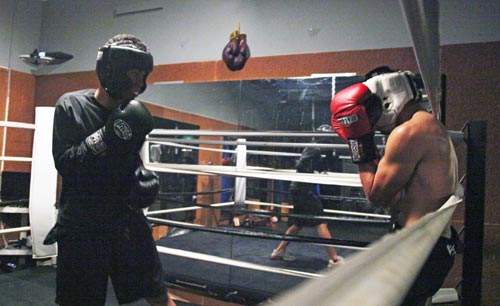
You MUST learn how to survive when you’re hurt.
Advanced fighters are especially good at minimizing damage and buying themselves precious time to recover. They know how to keep moving, how to stall and hold and shake off aggressive opponents. They know how to protect themselves when they’re unable to fight back.
You might be hurt, or injured, or tired, or have something caught in your eye. Or maybe you’re ahead on points and don’t have the energy to maintain the pace. Knowing how to survive can keep you from getting knocked out.
Here are some fight survival tactics that have kept me up until the final bell:
How to Survive When You’re Hurt
1. Move AROUND your opponent
You need time to recover. Keep moving. Either move your head or move your feet but keep yourself moving to minimize the number of consecutive shots he can land on you. When you move, try to move in different directions around your opponent. Don’t just run straight away. Try to go around him, then under him, then through him, then away from him, then over him. This will make it hard for him to chase you down. He’ll be throwing wildly but many of those will not be the crucial shot.
Change directions and change your levels. Up or down. Left or right. Near or far. You don’t have to be fast as long as you keep changing directions. The worse thing you can do is to keep running away from him as you will only get tired and he will easily save energy by walking calmly to you.
2. Make contact
Grab his arms, or his shoulder, or his head. It’s not legal to literally grab your opponent but maybe you can pinch his head or his arm between your elbow and your waist. Or you can push him down with your chest if he rolls under you. You don’t have to grab both arms. You can reach around him on one side and use that to off-balance him.
The only time I can think of when it’s not good to make contact is when your opponent is so much bigger than you that he can throw you off balance easily.
3. Look for the obvious counters
Throw a counter right over his jab. Or slip outside his right hand and throw a left hook. Or trade right hands or trade left hooks with him. Look for that one punch that you know and trust very well and put 100% of your power into it. I’m not asking you throw a full power combination. But at least have one good punch you can rely on. Hitting your opponent HARD is the only way to make him back off.
4. Slow the fight down
Once you’ve fully recovered, slow the fight down! The best way to keep the fight from becoming a gunfight is to make it a moving fight so both guys are busy moving rather than punching. Moving less or standing still is only going to slow you down; what you need to do is slow down YOUR OPPONENT.
How to Stall a Fight
Stalling on the OUTSIDE vs Stalling on the INSIDE
This is an interesting debate. There are many schools of thought when it comes to stalling a fight. Some guys like to stall a fight by just flat out running away. Your opponent can’t do anything to you if he can’t reach you. It makes a lot of sense and works well especially if you have a range advantage or more energy or more mobility. The harder you try to chase the runners, the more careless you get and the more likely they land a wild potshot on you.
On the other hand, some guys like to stall a fight by coming inside. They’ll lean on you, clinch, grab your arms, head butt you, step on your foot, push you off balance and do all sorts of dirty things on the inside. Every now and then, they’ll swing a haymaker over the top to keep you cautious and you’ll feel like you have to keep backing up to make space for your shots.
I personally like to go inside. Staying inside requires much less energy so it’s easier to do this over an entire round whereas running away from your opponent is hard to do for an entire round. Staying inside also requires more skills as you’re in close range with a powerful opponent. I like being close because it allows me to use my whole body (chest, shoulders, arms) to put pressure on my opponent from all angles. Over the years, I’ve learned many tricks to control opponents on the inside and wear them down without having to use much energy.
What punches to throw
Some guys will throw constant jabs and occasional power shots. Some guys throw pure potshots. Some guys will stay quiet for a minute and then respond with a quick flurry before running again. Some guys will wait for the KO shot and throw it with 100% force if they see the opportunity. It depends on your body’s natural rhythm and how much energy you have left. Throw what you can.
Changing the distance
Playing with the distance is a great way to control a fight but there is one problem, you have to actually throw punches. Otherwise, your opponent will walk in on you and take whatever distance he likes best. You have to at least make your opponent cautious of your punches if you want to play with the range. Learn how to bait with long jabs. Stick your head in sometimes and pull it back other times.
Changing the angles
I love changing angles because it’s so much fun and very easy to do. It’s more effective at close range as head movements will result in bigger angles when you’re closer to your opponent. From far range, you feel like all head movements still leave you in front of your opponent. From close range, you feel like you can almost get behind an opponent with the same amount of head movement.
How to Stall a Fight from the Outside
1. Run
Running takes lot of energy so you’ll have to be clever about it. Put your arms down and shuffle away from your opponent. Rest your arms and breathe and keep moving around. When he gets close, you can go back into your defensive stance but otherwise, just break your stance and dance away. Twist and turn your body anyway you want to help you move easily. You’re in running mode, not fighting mode.
Change directions
Take a few steps to the right and just as he’s about to load up a punch for that side, you go the other way. Then turn back, then turn back again, maybe fake a punch and change directions yet again. The tip is to change directions when you think he’s about to punch. Otherwise, you’re just wearing out your legs for no reason.
2. Bait and escape
Give him one shot. For example, leave your front arm down to bait for his right hand. You can help it by throwing lazy jabs on purpose or just leaving your left hand far out there to push his head away. The moment you see his right hand, duck under and escape through his armpit.
Likewise, you can also bait for his left hook and then roll under and out of range again when he goes for it. Bait for a punch and escape it. Easy as that.
3. Potshot
Assuming you’ve been running around with your hands down. You can definitely land a few surprise shots in there if he’s not expecting you to punch. Try a tricky left hook or a lead right every now and then to keep him cautious. It helps to throw some flurries or fast combinations to keep him on his toes. You can also fake a punch every now and then before throwing a real one.
4. Walk and block
Another way to run is to hold a guard and to keep walking away from him. You don’t have to jump or skip—just walk calmly. As long as you’re constantly in motion, it’ll be hard for him to set his feet for power shots. The big mistake is to jump or to run—this leaves you with tired legs which allows him to eventually catch up to you. Remember, it’s harder to punch while moving than it is to defend while moving. Keep the fight moving!
How to Stall a Fight from the Inside
1. Keep turning your opponent
The best way to stall a fight is to keep it moving. It’s too much energy to keep running so the best thing you can do is to keep turning your opponent. Either he runs into you and you pivot to deflect his energy away. Or you can walk into his shoulder (either shoulder) to force him to turn. Of course, you’re not pushing with your hands, you’re using your chest and your body to walk into his body as you fight him on the inside. Even the act of standing at an angle from him will force him to adjust his position in order to hit you.
Keep turning him and he’ll have to keep resetting his stance in order to hit you. The easiest way to turn to somebody is when you’re in close range. This way, one step can greatly offset your body angles. If you’re far away, you can run all you want and you’ll still be in front in of him.
2. Shoulder roll
The easiest way to defend against punches on the inside is to keep rolling his punches. Most guys throw with a constant LEFT-RIGHT-LEFT-RIGHT rhythm. Once you know his rhythm, you can stand in front of him and keep rolling off his shots.
3. Move your head (near, far, and under)
Bring your head right in front of his and then pull it away when he attacks. You can also place it far away and then roll it under when he attacks. Or place your head low and then lift it up when he attacks. Keeping your head moving on the inside is a great way to make him miss.
4. Keep touching him
Nobody likes to be touched. Even just laying my glove on an opponent’s shoulder will make him uncomfortable. You can also place your glove on his head, or maybe his glove, or keep it touching his chest or his face. It’ll make him cautious and tense and uneasy because he feels like something is threatening him. Or he’ll be irritated by the contact and will want to get you off him immediately. This is a great way to make an opponent throw a wild counter in frustration.
Constantly touching an opponent is a great way to wear out a heavily muscled opponent. Muscular opponents will activate their muscles whether it’s an explosive movement or not. So my trick is to make them activate their muscles as much as possible and I do this by constantly pushing him around on the inside. I keep a constant point of contact on his body and watch him wear him out. Sometimes my hand is on his chest, other times on his shoulder, or his neck or even just on top of his head and it’s amazing to see how uncomfortable he is.
5. Push from an angle
Keep pushing him around from different directions. Use your body contact to apply pressure at an angle to off-balance him and/or force him to readjust his stance. Never push straight on, this is a waste of energy and also allows him to direct your energy elsewhere. The trick is to keep projecting your energy in a circle around him. Always direct your force into one side of his body, not the center (this makes it harder for him to push back). Your goal is to turn him, not to move him. You want him to waste his own energy moving himself.
Anytime your opponent ducks under you for some reason, lean on him with your chest and wear out his back. This will buy you some time until the ref breaks you guys again.
6. Pull from an angle
In moments that you can’t push him because he’s leaning on you or because you’re falling backwards. You can also latch yourself onto one side of his body (the shoulder or arm or waist) and let your falling momentum spin him around you. (I’ll have to demonstrate this in a video later.) It’s especially easy to pull someone if you’re both spinning around each other at close range. You can also try pulling him a little to make him resist the pull then switch directions and push him back. And then punch him! Constantly pushing and pulling a guy on the inside will wear him out quickly!
7. Clinch
Use your head and arms to control his body. Hang on him or push him around to wear him out. You can also use an under clinch to swing him around you (or take him with you if you fall). Under clinches are great for spinning and also looks good in competition because it doesn’t look as obvious to judges.
8. Change your stance
Inside fighting is a very messy way of fighting. You’ll have to keep readjusting your position and it’s important to know that you have to switch stances often. Place your feet wherever they need to be in order for you to feel comfortable and fight from that position. You’ll end up more square and even southpaw very often.
9. Take punches on the top of your head
Keep your chin down during wild exchanges so that his punches can land on the top of your head (which does less damage). Any time that you miss a punch and feel like you can’t avoid his counter in time, duck your head down into the punch (using your neck preferably over your waist) so his punches lands on the top of your head.
10. Make contact when you miss your punches
Anytime that you swing and miss, let your momentum throw you on top of him. Your body weight can smother him and block him from throwing a counter. You can also use this opportunity to clinch. When I’m completely tired, I like to swing haymakers into my opponent. If it lands, great. If he blocks it, I still get to make contact and clinch him for a bit.
Keep Your Opponent Moving
The best way to stall the fight is to keep the fight moving. Now you can move yourself, which would tire you out, or you can make your opponent move which can be done through clever use of head movement and body contact. Mix in some slick defense with a few clinches and you’ll be able to slide your way out of danger.
What I like to do is change directions and throw potshots at long range. Once he comes close, then I come in as well and use my body contact to push him and turn him and create angles for him to miss. He can throw all he wants but he’ll never hit me if I don’t set myself in front of him and don’t let him set himself in front of me.
The more your opponent has to move,
the less he can focus on hitting you.
Slow your opponent down early in the fight.
The best time to slow down the fight
is BEFORE you get tired.
This is why the experienced guys take it easy early in the fight. They use all sorts of tactics to slow the fight down and take their time. In the meanwhile, their opponent is wasting energy, they’re figuring out their opponent’s fighting style and fighting rhythm without being risky.
And then once you feel comfortable and you’ve got him figured out, then you can go lay some bombs on him. The beginners on the other hand are always rushing in with bombs before figuring out their opponents and that’s how they get hurt.





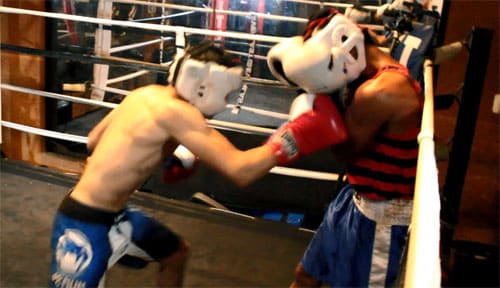
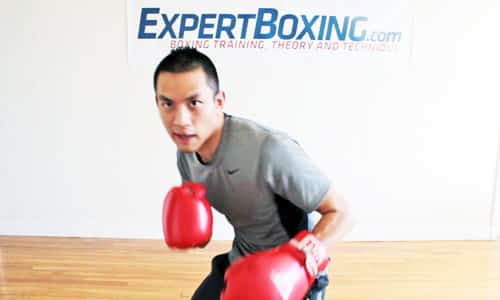


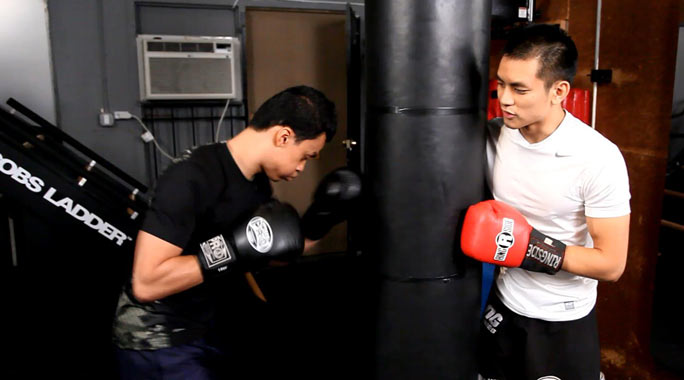
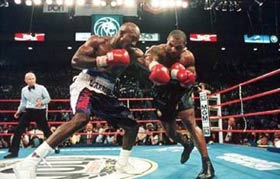
The science of boxing seems more and more complicated.
Great info, Johnny. You answered a lot of my questions about inside fighting Can u write a article specifically for in-fighting? Thnx for all your hard work and dedication, man. I’m a better boxer because of u. I just bought your advanced footwork video on Father’s Day, and I can already feel the extra power and balance. The “penis” trick works awesome. Thnx again, bro!
The in-fighting guide is in the works…it will be a huge series so that’s why it’s taking me forever to write. I’m glad you enjoyed the tricks. Keep working on everyone because they will all increase your punching power greatly! (Check out my footwork guide when it comes out…SOON!)
Johnny, I’m definitely lookin’ foward to this inside fighting guide, that’s really an issue for me. If you could make a video explaining this tricks it would help a lot. Great website, I’m from brazil and I’m really gettin’ better ’cause of expertboxing.com. great work!!! (sorry ’bout any english mistake, not my native language)
Hi Ricardo, check out http://www.expertboxing.com.br! 🙂
looking forward to that inside fighting series. nice work bro
Awesome article inside info to see how guys like mayweather or Lenard get hurt than recover to still dominate the fight or out outsmart the more dangerous opponents I love this website read it everyday please keep writing
ey bro!
one quick question can I use this ones Rival High Performance Lace-Up
Pro Sparring Gloves – Long Cuff for trainning and bag hitting? or are they only meant for sparring? I dont want to waste them….
thanks!!!
I’m not Johnny, but in my opinion it’s better to have a dedicated pair for sparring and one for bag work & mitts.
A. Sparring gloves tend to be 16 ounces. Bag gloves are typically 10-14 oz. Some might argue it’s better to use 16 for all, that way you don’t get used to lighter gloves. But I think you can improve coordination and speed with smaller gloves when doing bag/mitt work.
B. Bagwork will compress the glove padding, making them harder than dedicated sparring gloves. You will inflict unnecessary impact on your sparring partners.
C. The most obvious problem here, is they are lace-ups. A lot of bag and mitt-work is done on your own, you simply might find it a hassle to have to ask someone to help lace-up or remove your gloves for you each time you practice. Most bag gloves are velcro, making drinking water and going to the bathroom pretty hassle-free.
However, aside from the above – technically there isn’t any reason why you can’t use sparring gloves for bag work. If you’re concerned about wear & tear, then yes they will wear twice as fast if you use them for both. I recommend an affordable pair of bag gloves. Or simply use the ones your club provides.
Sparring gloves probably means they’re made for sparring not hitting the bag. You’ll wear down their padding quickly if you hit the bag with them.
Good article. I agree on many points. I am similar in that I like to clinch up w/my sparring partner when i’m tired. I can’t tell you how many times i finish multiple rounds with someone else, then coach throws in a fresh newbie who’s gonna fight scared and swing for the fences. I like to clinch up, which makes them nervous and they put all their energy into pushing me away. Then a short time later, they are huffing and puffing and amazed by my astronomical cardio, when really, all I did was use my experience to my advantage.
Yes, inside-fighting is especially easy and effective to do against the lesser experienced guys.
Hey,
On the topic of surviving one of the most devastating punches a boxer can throw at me is usually in the centre of my chest, or my lower abdominal muscles. If I remain in my defensive stance when I’ve taken a big hit, I find that I almost instinctively move my arms outwards to protect my head from catching a right hand or a left hook- which is what normally is being flung, and while countering or slipping away, a right hand can fall into my chest, causing an enormous amount of pain that can put me down. Likewise, if I move my guard up to protect my head, I can start getting barraged with uppercuts to the lower body which really sting, but can also sometimes break through my guard to the chest area (assuming I’m facing square on in a peekaboo type stance, which is rare).
Do you know any productive ways in which to strengthen (mainly) the chest muscle area, but also the lower abdomen? I have also noticed that if I land punches that are square on the chest on my opponent, they usually go down hard or attempt to clinch wildly.
Thanks!
What many boxers like to do is sit-ups and crunches to help make the body stronger at taking shots. But to me, technique is key.
What would a defensive minded fighter think ?
I imagine the article I wrote would be how most defensive-minded fighters would think.
beautiful. lots of great info. as an offensive guy, ive seen what makes me stop when attacking. or rather take my time. its the little things you pointed out. punching hard makes me wary. makes me think. taps will tire out a tired guy more than they’ll bother me. it tells me i can walk through him.
and “its harder to punch while moving than it is to defend while moving” is gold advice. even fighters just walking slowly make it impossible to set up a good punch following them. one has to learn to cut the ring off.
always primarily move away from their best or favorite punch. not 100% of the time, most of the time. change up, specially when you see them setting for a punch or to stop you going that direction. deciding whether to move in or away depends on the kind of fighter. are they better in close, crafty ? do they have uppercuts, short short hooks ? fight outside.
do they move forward with long arms, do they strafe with punches, have combos or use their momentum ? is their power at the end of their punches? get into them, dont let them build momentum,
a hurt fighters balance will suck so they will look for the ropes. its ok if one is tired, but not if one is hurt aka unable to concentrate on seeing punches and dodge then with balance. i would rather pull a hopkins, step into a fighter with my head and my right hand aimed at him.
if inside, keep chin down, and way from the opponent’s free hand (the long hand). lean into him, and if he’s putting pressure either grab him over the top of his head and pull down or try to move around. or just fall down (aka david haye) but dont do it on a punch. you can slow him down with punches to the solar plexus, the liver. do not let him get free, lock the arms and hit wherever possible. the little tap hits dont do damage they lull the opponent into repaying with the same. which is useful to get time.
if moving away, keep your arms out in front of you as if youre ready to shove back. arms down is a psychological thing i think that makes attackers want to finish you off. its like saying `im done, take me’ while keeping the arms up says `im still dangerous.’ obstruct vision with longer arms if u have em. move with feet square, or if too tired for that walk away perpendicular and circular looking over your shoulder. watching guys like whitaker taught me just how safe this was. if hurt and jumping light punches can drop a fighter because it wasnt seen or fighters tired of offbalance. walking relaxed slows the offensive guy. tells them hes still dangerous. keep looking at the opponent even with your with head down. that gives a chin 10% more impact absorbtion.
punch at their chest if theyre fast, and punch withsame hand as their long arm if theyre slower. punches will cancel. if they are open go for it and immediately clinch
if he gets close, use a move-into-clinch move. or put your hands into his face and push away or push/pull the head down. the correct spacing is very important, if youre short or extend too early (some fighters will fake coming in so a hurt opponent tries to clinch) you are even more vulnerable and square. some sparring partner should show you how if possible.
Perhaps I’m missing the point, but I’ve watched numerous videos of Guilermo Rigondeaux training where he appears to be intentionally making himself dizzy and disoriented by spinning around (in place) at a fast rate for a few seconds, then stopping for a second, then start shadowboxing as if nothing happened.
In addition to the spinning in place drill, he also does a series of forward/backward rolls, similar to what beginning gymnasts do, going around the perimeter of a towel that’s lying fully opened and flat in the center of the ring. As soon as he does a few passes around it, he pops up and starts shadow boxing and moving, again, as if nothing happened.
I imagine that this would be a more optimal way to train oneself in how they’d like to react/respond to being rocked/dropped/hurt than enduring any additional and unnecessary blows to the head to get the same/similar effect. At least this is the only sense I can make of it. If there is a different answer and you can explain it, I don’t mind being wrong.